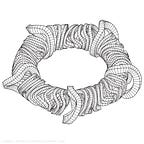Control Architectures in Unmanned Aerial Vehicles (UAVs): Open-Loop, Closed-Loop, and Hybrid Systems
Introduction
Unmanned Aerial Vehicles (UAVs) are becoming increasingly prevalent in various industries, from aerial photography and agriculture to search and rescue operations. At the heart of every UAV is a control system that ensures stable flight and accurate navigation. There are three primary types of control architectures employed in UAVs: open-loop, closed-loop, and hybrid systems. This article will delve into the intricacies of each type, exploring their advantages, disadvantages, and applications.
Open-Loop Control Systems
An open-loop control system provides a positive control signal, such as commands to move faster, slower, left, right, up, or down, without incorporating feedback from sensor data. In other words, the system issues commands based on a predefined set of instructions without considering the actual flight conditions or external factors.
Advantages of Open-Loop Control Systems:
- Simplicity: Open-loop systems are generally less complex and easier to implement.
- Speed: Since the system does not rely on feedback, response times can be faster.
Disadvantages of Open-Loop Control Systems:
- Lack of Accuracy: Open-loop systems are less accurate due to the absence of feedback, which can lead to deviations from the desired path or behavior.
- Inability to Adapt: These systems are unable to adapt to changing conditions or disturbances, potentially leading to unstable flight.
Closed-Loop Control Systems
In contrast, closed-loop control systems incorporate sensor feedback to adjust the UAV’s behavior. This feedback allows the system to account for external factors, such as tailwinds, and make necessary adjustments, like reducing speed or changing altitude. The Proportional-Integral-Derivative (PID) controller is a common type of closed-loop system used in UAVs. Sometimes, feedforward control is employed, transferring the need to close the loop further.
Advantages of Closed-Loop Control Systems:
- Increased Accuracy: By incorporating sensor feedback, closed-loop systems offer better accuracy and performance compared to open-loop systems.
- Adaptability: These systems can adapt to changing conditions and disturbances, providing a more stable and controlled flight.
Disadvantages of Closed-Loop Control Systems:
- Complexity: Closed-loop systems are generally more complex and harder to implement than open-loop systems.
- Slower Response Times: Due to the need for feedback processing, closed-loop systems can have slower response times compared to open-loop systems.
Hybrid Control Systems
Hybrid control systems combine elements of both open-loop and closed-loop control architectures. These systems aim to leverage the advantages of both types while minimizing their respective drawbacks. For instance, a hybrid system may use an open-loop approach for general navigation but switch to a closed-loop system for precise altitude control or when facing unpredictable disturbances.
Advantages of Hybrid Control Systems:
- Flexibility: Hybrid systems offer greater flexibility by combining the strengths of open-loop and closed-loop control architectures.
- Improved Performance: By adapting to specific situations, hybrid systems can provide better overall performance compared to strictly open-loop or closed-loop systems.
Disadvantages of Hybrid Control Systems:
- Increased Complexity: Combining elements from both control architectures can result in more complex systems that may be challenging to design and implement.
- Potential Inefficiencies: In some cases, hybrid systems may not be as efficient as dedicated open-loop or closed-loop systems, depending on the specific application.
Conclusion
Understanding the differences between open-loop, closed-loop, and hybrid control architectures is essential for designing and optimizing UAVs for various applications. Each type has its own set of advantages and disadvantages, with open-loop systems offering simplicity and speed, closed-loop systems providing accuracy and adaptability, and hybrid systems
